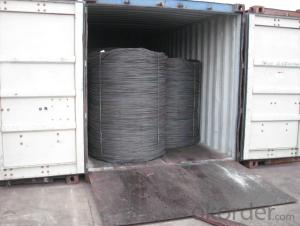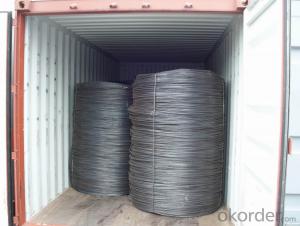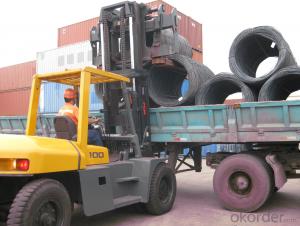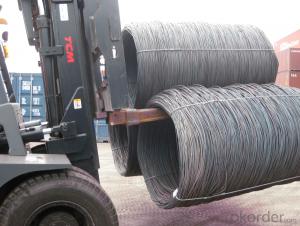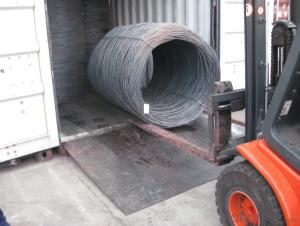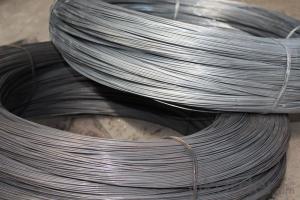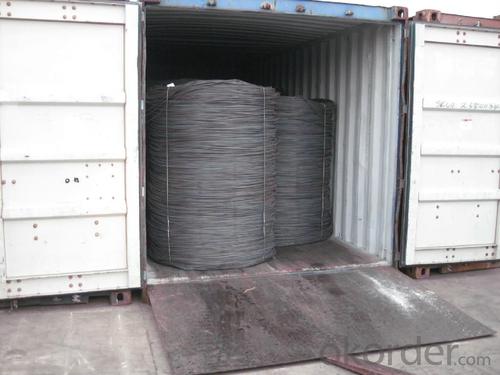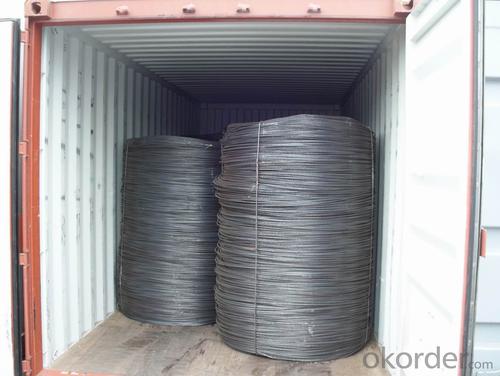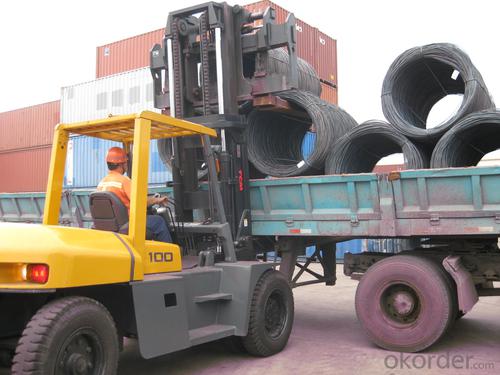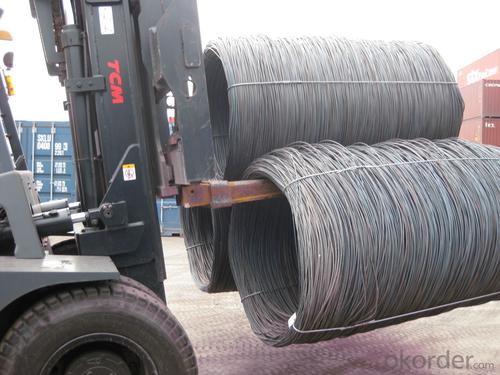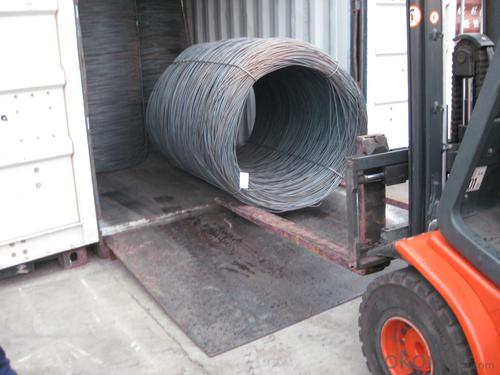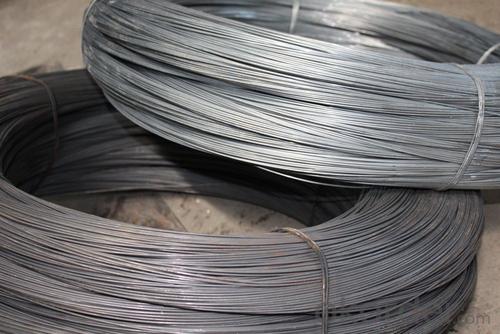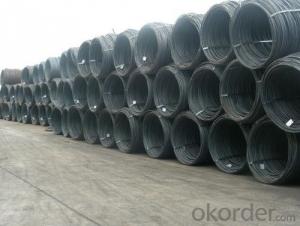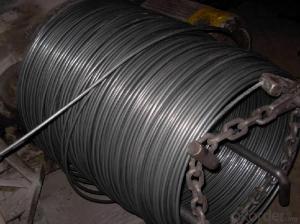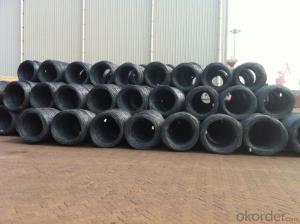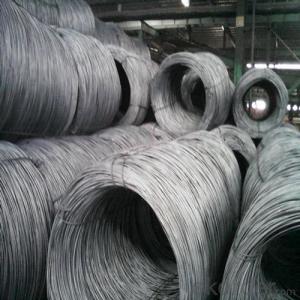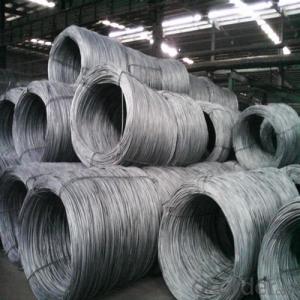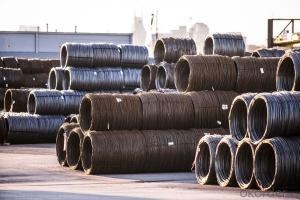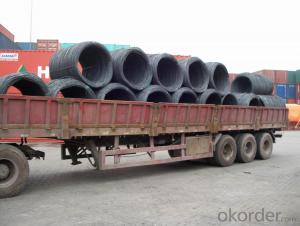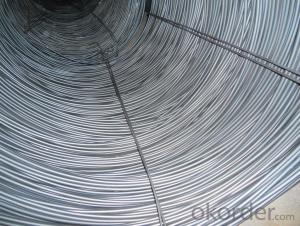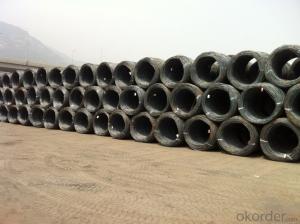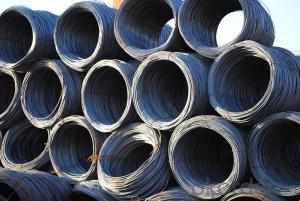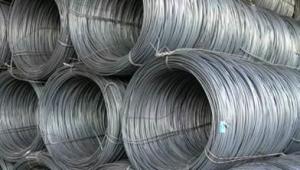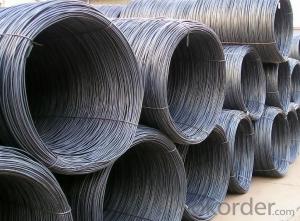SAE1006Cr Carbon Steel Wire Rod 9mm for Welding
- Loading Port:
- Shanghai
- Payment Terms:
- TT OR LC
- Min Order Qty:
- 100 m.t
- Supply Capability:
- 30000 m.t/month
OKorder Service Pledge
OKorder Financial Service
You Might Also Like
Specification
Description of SAE1006Cr Carbon Steel Wire Rod 9mm for Welding:
OKorder is offering Color Coated Steel Coil Prepainted Steel Coil at great prices with worldwide shipping. Our supplier is a world-class manufacturer of steel, with our products utilized the world over. OKorder annually supplies products to European, North American and Asian markets. We provide quotations within 24 hours of receiving an inquiry and guarantee competitive prices.
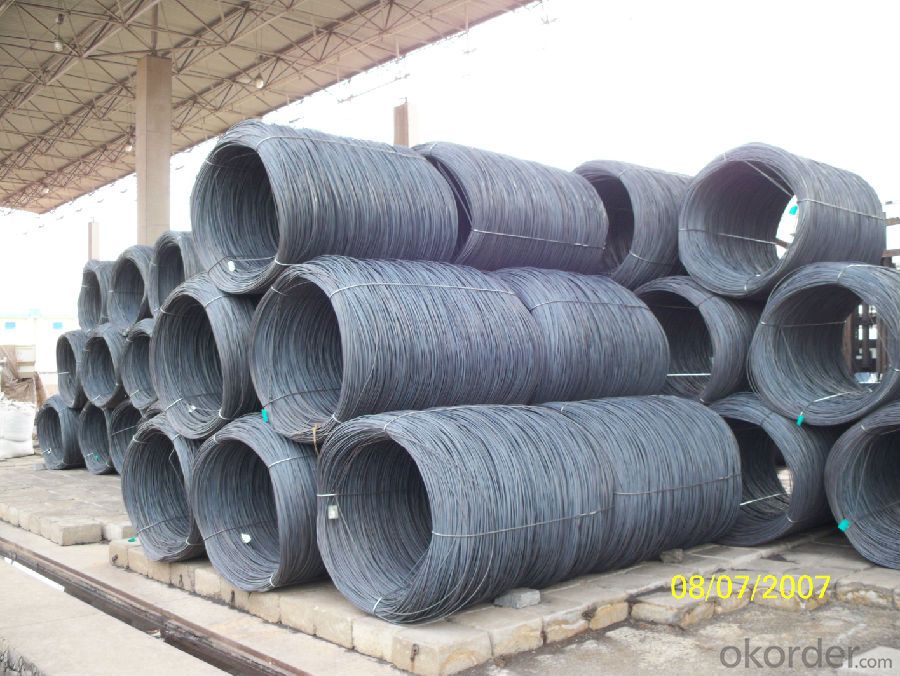
Applications of SAE1006Cr Carbon Steel Wire Rod 9mm for Welding:
Color Coated Steel Coil Prepainted Steel Coil are ideal for structural applications and are widely used in the construction of buildings and bridges, and the manufacturing, petrochemical, and transportation industries.
Main Product Features of SAE1006Cr Carbon Steel Wire Rod 9mm for Welding:
· Premium quality
· Prompt delivery & seaworthy packing (30 days after receiving deposit)
· Corrosion resistance
· Can be recycled and reused
· Mill test certification
· Professional Service
· Competitive pricing
Specifications of SAE1006Cr Carbon Steel Wire Rod 9mm for Welding:
PPGI:
1, Introduction: Color coated steel coils(sheets), i. E. PPGI, also called prepainted steel coils(sheets), are made of galvanized steel coils(sheets) with polymer coatings as surface. It's a new enclosure material and building board with characteristics of light-weighted, heat preserved&insulated, easily installed with bright colors.
2, Production Process: Pretreatment(Degreasing)_Drying_Chromating_Paint Basic Oil_Cooling_Drying_Color Coating_Cooling_Film-covering_Rolling Up
3, Characteristics:
Good at corrosion resistence. Besides zinc coating of the basic plate of galvanized steel sheet, the color coating as the surface has double lifetime to ensure better anticorrosion effect.
With excellent cold bending molded manufacturablity, PPGI products can be processed or directly used as final product. As being light-weighted and conveniently transported, they're widly used to replace wood to save energy.
4.There're thousands of colors can be chosen as per different application. Any color plays well in decoration.
No pollution with high recycling rate, PPGI coils and sheets are strongly recommended as enviroment-friendly products by the government.
5, eye bands and 4 circumferential bands in steel, galvanized metal fluted rings on inner and outer edges, galvanized.
| commodity | SAE1006Cr Carbon Steel Wire Rod 9mm for Welding |
| Techinical Standard: | JIS G3302-1998, EN10142/10137, ASTM A755 |
| grade | Q195,Q215,Q235,SAE1006,SAE1008 SAE1006Cr |
| Types: | Mesh welding |
| Base metal | galvanized, galvalume, cold rolled steel |
| Thickness | 0.14-1.0mm(0.16-0.8mm is the most advantage thickness) |
| Width | 610/724/820/914/1000/1200/1219/1220/1250mm |
| Type of coating: | PE, SMP, PVDF |
| Zinc coating | Z60-150g/m2 or AZ40-100g/m2 |
| Top painting: | 5 mic. Primer + 15 mc. R. M. P. |
| Back painting: | 5-7 mic. EP |
| Color: | According to RAL standard |
| ID coil | 508mm610mm |
| Coil weight: | 2--3MT |
| Package: | Properly packed for ocean freight exportation in 20'containers |
| Application: | Industrial panels, roofing and siding for painting/automobile |
| Price terms | FOB, CFR, CIF |
| Payment terms | 20%TT in advance+80% TT or irrevocable 80%L/C at sight |
| delivery time | 25 days after recepit of 20% TT |
| Remarks | Insurance is all risks |
| MTC 3.1 will be handed on with shipping documents | |
| We accept SGS certificatation test |
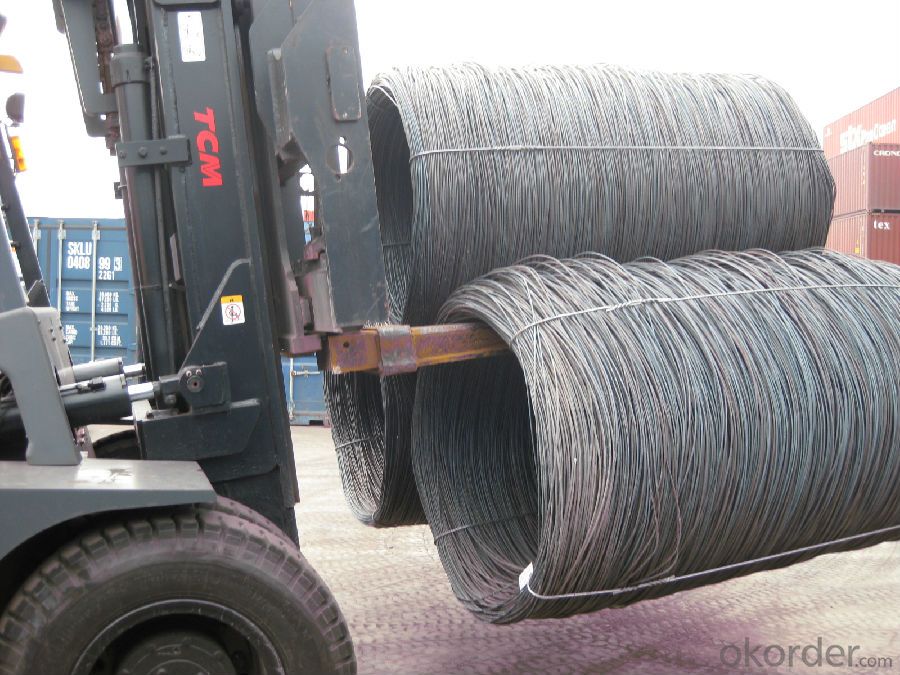
FAQ of SAE1006Cr Carbon Steel Wire Rod 9mm for Welding:
Q1: Why buy Materials & Equipment from OKorder.com?
A1: All products offered byOKorder.com are carefully selected from China's most reliable manufacturing enterprises. Through its ISO certifications, OKorder.com adheres to the highest standards and a commitment to supply chain safety and customer satisfaction.
Q2: How do we guarantee the quality of our products?
A2: We have established an advanced quality management system which conducts strict quality tests at every step, from raw materials to the final product. At the same time, we provide extensive follow-up service assurances as required.
Q3: How soon can we receive the product after purchase?
A3: Within three days of placing an order, we will begin production. The specific shipping date is dependent upon international and government factors, but is typically 7 to 10 workdays.
Q4: What makes stainless steel stainless?
A4: Stainless steel must contain at least 10.5 % chromium. It is this element that reacts with the oxygen in the air to form a complex chrome-oxide surface layer that is invisible but strong enough to prevent further oxygen from "staining" (rusting) the surface. Higher levels of chromium and the addition of other alloying elements such as nickel and molybdenum enhance this surface layer and improve the corrosion resistance of the stainless material.
Q5: Can stainless steel rust?
A5: Stainless does not "rust" as you think of regular steel rusting with a red oxide on the surface that flakes off. If you see red rust it is probably due to some iron particles that have contaminated the surface of the stainless steel and it is these iron particles that are rusting. Look at the source of the rusting and see if you can remove it from the surface.
- Q: What are the common production processes for curium-coated steel wire rod?
- The common production processes for curium-coated steel wire rod typically involve several steps. First, the steel wire rod is cleaned and prepared to remove any impurities and contaminants. Then, it goes through a coating process where curium, a radioactive element, is applied to the surface of the wire rod. This coating is usually done using a specialized method such as electroplating or chemical deposition. Finally, the curium-coated steel wire rod is inspected for quality control and may undergo further treatments or processing before it is ready for use in various applications.
- Q: How is steel wire rod used in the production of wire for jewelry making?
- Steel wire rod is an essential component in the production of wire for jewelry making as it serves as the raw material. The steel wire rod is first drawn through a series of dies to reduce its diameter and create the desired thickness for the jewelry wire. This process, known as wire drawing, results in a smooth and consistent wire that can be easily manipulated and shaped into various jewelry pieces such as rings, necklaces, and bracelets.
- Q: What are the common industry skills for steel wire rod professionals?
- Some common industry skills for steel wire rod professionals include knowledge of metallurgy and materials science, proficiency in operating and maintaining machinery and equipment, understanding of quality control and inspection techniques, ability to interpret technical drawings and specifications, strong problem-solving and analytical skills, familiarity with safety protocols and procedures, and effective communication and teamwork abilities.
- Q: How is steel wire rod used in the manufacturing of wire forms for bridge cables?
- Steel wire rod is used in the manufacturing of wire forms for bridge cables as it serves as the primary raw material. The wire rod is first drawn through a series of dies to reduce its diameter and increase its strength. This process, known as wire drawing, ensures that the resulting wire is of high quality and meets the required specifications for bridge cables. The wire is then further processed and formed into various shapes and sizes to create the wire forms used in bridge construction. These wire forms are crucial for providing the structural support and tensile strength needed to withstand the heavy loads and stresses experienced by bridge cables.
- Q: How is steel wire rod used in the manufacturing of springs for mattresses?
- Steel wire rod is used in the manufacturing of springs for mattresses as it provides the necessary strength and durability required for the springs to support the weight of a person. The wire rod is typically coiled and shaped into various spring designs, such as Bonnell or pocket springs, which are then incorporated into the mattress structure. The high tensile strength of steel wire rod ensures that the springs can withstand repeated compression and provide optimal support and comfort for sleepers.
- Q: What are the standard ductility requirements for steel wire rod?
- Typically, industry standards and specifications define the standard ductility requirements for steel wire rod. These requirements can vary depending on the intended use of the wire rod. In essence, ductility refers to a material's ability to deform without breaking under tension. Steel wire rod requires a certain level of ductility in order to be easily formed, bent, or stretched without fracturing. The specific ductility requirements for steel wire rod are typically indicated by the elongation percentage, which is determined through tension testing. The elongation percentage is calculated by measuring the increase in length of the wire rod after it breaks during the test. Common industry standards, such as those established by the American Society for Testing and Materials (ASTM), usually specify minimum elongation requirements for different grades of steel wire rod. These requirements can differ based on factors like wire rod diameter, manufacturing process, and intended use. For example, ASTM A510/A510M-18a, which covers general requirements for carbon and alloy steel wire rods and coarse round wire, specifies minimum elongation percentages ranging from 10% to 30% depending on the wire rod diameter. Other standards, such as those set by the International Organization for Standardization (ISO) or national standards bodies, may have similar or slightly different requirements. It is important to note that specific applications may have additional requirements beyond the standard ductility specifications. Certain industries, for instance, may require enhanced ductility to meet specific performance criteria or to ensure the wire rod can withstand severe deformation without rupturing. Overall, the standard ductility requirements for steel wire rod are determined by industry standards and specifications, which typically establish minimum elongation values. These requirements guarantee that the wire rod possesses the necessary deformability to meet its intended use and manufacturing processes.
- Q: How are surface defects in steel wire rod classified?
- Surface defects in steel wire rod are classified based on their characteristics and appearance. Some common classifications of surface defects in steel wire rod include: 1. Scale: Scale defects occur when the steel wire rod is exposed to high temperatures during the manufacturing process and forms a layer of oxide on its surface. Scale defects may appear as a rough, flaky, or scaly surface and can negatively affect the wire's performance. 2. Pits: Pits are small depressions or cavities on the surface of the steel wire rod. They can be caused by various factors such as corrosion, improper handling, or manufacturing defects. Pits can weaken the wire's structural integrity and compromise its functionality. 3. Scratches: Scratches are superficial marks or grooves on the surface of the steel wire rod. They can occur during handling, transportation, or manufacturing processes. Although scratches may not significantly impact the wire's strength, they can affect its appearance and may lead to further corrosion if left untreated. 4. Cracks: Cracks are linear fractures that extend through the surface of the steel wire rod. They can be caused by improper cooling, excessive stress, or manufacturing defects. Cracks are considered severe defects as they can propagate and lead to catastrophic failure under load. 5. Inclusions: Inclusions are non-metallic particles or impurities embedded within the steel wire rod's surface. These can include slag, oxides, or foreign materials introduced during the manufacturing process. Inclusions weaken the wire's mechanical properties and can contribute to premature failure. 6. Decarburization: Decarburization is a process where the carbon content at the surface of the steel wire rod is reduced. It can occur due to improper heat treatment or exposure to high temperatures. Decarburization weakens the wire's hardness and can negatively impact its performance. 7. Lamination: Laminations are layers or separations within the steel wire rod that occur during the rolling process. They can be caused by inadequate bonding between layers or impurities within the steel. Laminations can weaken the wire's structure and compromise its mechanical properties. Classifying surface defects in steel wire rod is crucial for quality control and ensuring the wire's reliability and performance. By identifying and categorizing these defects, manufacturers can take appropriate measures to minimize their occurrence and improve the overall quality of the wire rod.
- Q: How is steel wire rod used in the manufacturing of wire for mattress springs?
- Steel wire rod is an essential component in the manufacturing of wire for mattress springs. It serves as the primary raw material that is processed and transformed into the final wire used in the production of mattress springs. To begin the manufacturing process, steel wire rod is first carefully selected based on its specific properties, such as tensile strength, flexibility, and durability. These properties are crucial to ensure the wire can withstand the pressure and weight exerted on it when used in mattress springs. Once the appropriate steel wire rod is chosen, it undergoes a series of manufacturing steps. The first step involves heating the steel wire rod to extremely high temperatures, making it more malleable and easier to work with. This process, known as annealing, also helps to eliminate any internal stresses within the wire rod, making it more resistant to fatigue and prolonging its lifespan. After annealing, the steel wire rod is then cold-drawn through a series of dies to reduce its diameter and increase its strength and flexibility. This process, called wire drawing, involves pulling the wire rod through progressively smaller holes until it reaches the desired diameter. Once the wire rod is drawn to the correct diameter, it is further processed to enhance its surface finish and remove any imperfections. This can be achieved through various methods such as cleaning, polishing, or coating the wire with a protective layer. The final step in the manufacturing process involves coiling the wire into springs. The wire is fed into a specialized machine that coils it around a mandrel, forming the individual springs used in mattresses. The diameter and number of turns in the coil can be adjusted to meet specific requirements for different types of mattresses. In summary, steel wire rod plays a crucial role in the manufacturing of wire for mattress springs. It is transformed through processes such as annealing and wire drawing to enhance its strength, flexibility, and durability. The final wire is then coiled into springs, which provide the necessary support and comfort for mattresses.
- Q: How is steel wire rod used in the manufacturing of wire for medical implants?
- The manufacturing of wire for medical implants heavily relies on steel wire rod, which serves as the primary raw material. The wire is formed through multiple steps, starting with the careful selection of high-quality steel wire rod. This rod is then subjected to various manufacturing processes to create the final wire product. To ensure the highest standards and meet specific medical application requirements, the steel wire rod undergoes a thorough inspection for defects or impurities. This inspection guarantees the production of top-quality wire for medical implants. Once the wire rod passes inspection, it goes through the drawing process. Drawing involves pulling the wire rod through dies to decrease its diameter and increase its length. This process refines the wire's mechanical properties, like tensile strength and flexibility, to meet the demands of medical implants. After drawing, the wire undergoes further processing to improve its surface finish and eliminate any remaining impurities. Processes like annealing are used to heat and slowly cool the wire, enhancing its ductility and eliminating internal stresses. The final step in the manufacturing process involves conducting various quality control measures to ensure the wire's dimensional accuracy and mechanical properties. Tests such as tensile strength, hardness, and surface finish evaluations are carried out. Once the wire meets all quality control requirements and specifications, it can be utilized to manufacture a variety of medical implants. Depending on the specific application, the wire can be processed into coils or springs. Orthopedic devices like bone plates and screws, cardiovascular devices such as stents and guidewires, and surgical instruments like sutures and staples commonly utilize wire. In conclusion, steel wire rod is crucial in the production of wire for medical implants. It undergoes multiple manufacturing processes to ensure its quality, mechanical properties, and dimensional accuracy meet the specific requirements of medical applications. The wire is then utilized to manufacture a range of medical implants, which greatly contribute to enhancing patient outcomes and quality of life.
- Q: What are the different types of steel wire rod surface defects that can occur during wire drawing?
- During the wire drawing process, steel wire rods may experience a range of surface defects that can have adverse effects on the wire's quality and performance. These defects, which can be caused by different factors, include: 1. Scale: Arising from the hot rolling or annealing processes, scale refers to a thin layer of oxide that forms on the wire rod's surface. It manifests as a dark, flaky coating and can negatively affect the wire's ductility and adhesion. 2. Scratches: Wire rods can acquire visible lines or marks, known as scratches, during handling, transportation, or wire drawing. These scratches compromise the wire's strength and may lead to failure when subjected to stress. 3. Slivers: Small, elongated metal flakes, called slivers, can embed themselves on the wire rod's surface. They can originate from inadequate cleaning of production equipment or defects in the steel manufacturing process. Slivers pose risks such as wire breakage or surface roughness. 4. Scale pits: Depressions or cavities, referred to as scale pits, can form on the wire rod's surface due to the presence of scale or impurities during drawing. If sufficiently deep, scale pits can affect the wire's appearance and mechanical properties. 5. Decarburization: Decarburization occurs when the carbon content on the wire rod's surface diminishes, resulting in reduced strength and hardness. This phenomenon is commonly observed during high-temperature operations like annealing, and it manifests as a lighter or duller color compared to the wire's core. 6. Corrosion: Wire rods can undergo corrosion when exposed to moisture, chemicals, or other environmental factors. This corrosion can cause pitting, rusting, or discoloration on the wire's surface, adversely affecting both its appearance and mechanical properties. 7. Lamination: Lamination defects manifest as thin layers or flakes that detach from the wire's surface. They can arise from flaws in the steel manufacturing process or insufficient bonding between layers during wire drawing. Lamination defects significantly compromise the wire's strength and ductility. To ensure the production of high-quality wire products, manufacturers employ diverse techniques, such as surface cleaning, inspection, and quality control measures, to identify and minimize these surface defects during the wire drawing process.
Send your message to us
SAE1006Cr Carbon Steel Wire Rod 9mm for Welding
- Loading Port:
- Shanghai
- Payment Terms:
- TT OR LC
- Min Order Qty:
- 100 m.t
- Supply Capability:
- 30000 m.t/month
OKorder Service Pledge
OKorder Financial Service
Similar products
Hot products
Hot Searches
Related keywords
